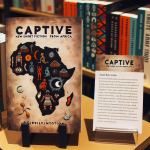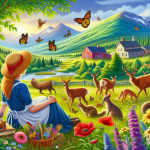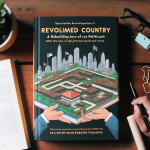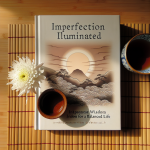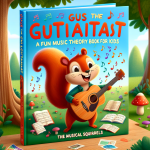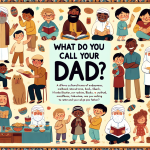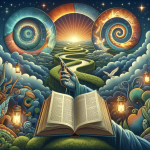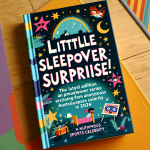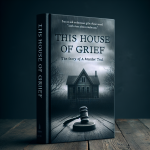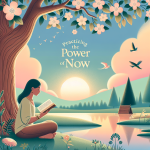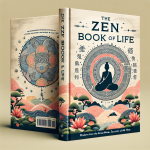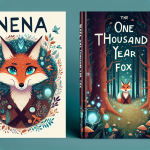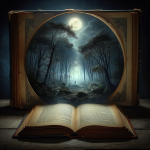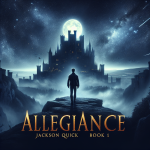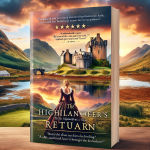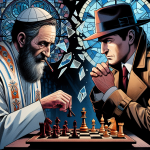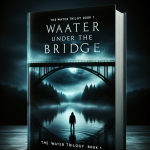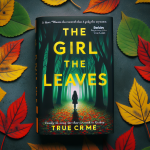As an Amazon Associate I earn from qualifying purchases.
Unveiling the Mystique of “Where the Forest Meets the Stars”: A Captivating Blend of Magic and Reality
Joanna Teale's journey in “Where the Forest Meets the Stars” is not just an expedition through grief and healing but a testament to contemporary fiction's power to intertwine the everyday with the extraordinary. This gripping narrative masterfully employs elements of magical realism to enrich a story deeply rooted in human emotions, friendships, and the healing process. The novel plunges readers into a world where the lines between reality and the fantastical blur, challenging the conventions of traditional character-driven stories.
In a landscape cluttered with formulaic plots, “Where the Forest Meets the Stars” stands out by solving the often-overlooked issue of emotional depth and authentic character development. It delves into the complexities of human relationships and personal loss, offering readers a rich, emotional journey that encourages reflection on their own lives. More than just a tale of coping and resilience, this book encapsulates the magic that can be found in daily encounters, portraying how unexpected friendships can illuminate the darkest paths.
Plot: “Where the Forest Meets the Stars” centers on Jo Teale, a bird researcher who has returned to her fieldwork after a battle with breast cancer. While working in a remote area, Jo encounters a mysterious, barefoot child named Ursa who claims to be an alien sent to witness five miracles. Jo, despite her reservations, decides to care for the child and teams up with her reclusive neighbor, Gabriel Nash. The novel skillfully intertwines themes of trauma, healing, and the inexplicable as Jo and Gabriel try to uncover the truth about Ursa's origins. Their journey is fraught with emotional and moral dilemmas, driving the narrative forward in an engaging and compelling manner.
Characters: The characters in “Where the Forest Meets the Stars” are richly developed and deeply human. Jo Teale is a determined and resilient protagonist, scarred by her past yet unwavering in her scientific pursuits. Gabriel Nash, a melancholic yet compassionate figure, complements Jo's character with his own struggles and vulnerabilities. Ursa, the enigmatic child, adds a layer of mystery and wonder to the story. Each character’s development is profound, revealing layers of personal trauma and emotional growth that are central to the narrative. Their interactions and relationships drive the character-driven story, making the reader invest deeply in their journeys.
Writing Style: Glendy Vanderah’s writing style in “Where the Forest Meets the Stars” is evocative and lyrical, enhancing the novel's emotional depth. She seamlessly blends descriptive prose with dialogue, creating a natural flow that immerses the reader in the story. Vanderah’s use of vivid imagery brings the natural setting to life, placing the reader in the midst of the forest where Jo conducts her research. Her ability to weave elements of magical realism into the storyline is subtle yet powerful, adding an ethereal quality to the narrative that keeps readers enthralled.
Setting: The setting of the novel is pivotal to its charm and atmosphere. The remote, forested area where Jo conducts her bird research provides a serene yet eerie backdrop that enhances the novel's themes of isolation and discovery. The natural environment plays a critical role in the storyline, symbolizing both a sanctuary and a mysterious realm where anything seems possible. This juxtaposition between the tangible and the unknown underpins the novel's magical realism, grounding the extraordinary elements in a realistic, beautifully depicted wilderness.
Unique Aspects: One of the unique aspects of “Where the Forest Meets the Stars” is its seamless integration of magical realism into a contemporary fiction context. Ursa’s claim of being an alien tasked with witnessing miracles introduces a fantastical element that challenges the characters' and readers' perceptions of reality. The novel also excels in its exploration of complex, emotional journeys, weaving together themes of illness, grief, and healing with the transformative power of friendship. Moreover, the character-driven narrative, combined with Vanderah’s lyrical writing and the evocative setting, creates a story that is both heartwarming and thought-provoking, standing out in the contemporary fiction landscape.
Contemporary Fiction: Contemporary fiction often addresses current social issues and personal struggles that resonate with modern readers. For example, Jo's battle with breast cancer and her emotional recovery highlight themes relevant to modern society, such as physical and mental health. The novel's setting in the present day allows for the inclusion of realistic elements and conflicts while exploring the complexities of human relationships. This genre's strength lies in its ability to capture the essence of modern life, providing readers with relatable and insightful narratives.
Magical Realism: Magical realism in “Where the Forest Meets the Stars” is exemplified through Ursa’s mysterious presence and her fantastical claims. This genre blurs the line between reality and fantasy, allowing extraordinary events to unfold in a seemingly ordinary world. Magical realism often serves as a metaphorical tool to explore deeper truths, and in this novel, Ursa's character poignantly reflects on themes of wonder, belief, and the unexplained. The novel's success in merging the magical with the real creates a unique, compelling reader experience, encouraging them to ponder the boundaries of reality and imagination.
Emotional Journey: The emotional journeys of the characters are central to the novel's impact. Jo's recovery from cancer and her gradual opening up to love and trust represent a profound personal transformation. Gabriel's story of loss and isolation similarly unfolds as he learns to connect and care again. Ursa’s presence catalyzes these changes, acting as a conduit for healing and self-discovery. The characters’ emotional evolutions are depicted with authenticity and sensitivity, highlighting the resilience of the human spirit and the redemptive power of compassion and connection.
Friendship Story: At its heart, “Where the Forest Meets the Stars” is a story about the transformative power of friendship. The bonds that develop between Jo, Gabriel, and Ursa illustrate how human connections can bring healing and hope. Their relationships grow from mutual necessity and curiosity into a deep, familial bond, underscoring the narrative's emotional richness. This aspect of the story shines a light on the importance of support systems and the profound impact that compassion and understanding can have on individuals confronting their past traumas.
Character-Driven: The novel’s strength lies in its character-driven approach. The plot advances primarily through the protagonists' motivations, decisions, and interpersonal relationships. This focus on character development allows for a rich exploration of themes such as loss, resilience, and the search for meaning in the face of adversity. By prioritizing character arcs over plot mechanics, the novel offers a deeply introspective reading experience, inviting readers to invest in the characters' emotional and psychological journeys.
In-Depth Information: “Where the Forest Meets the Stars” provides an in-depth look at various topics that enrich its narrative. For instance, Jo's ornithological research is portrayed with accuracy and detail, reflecting Vanderah's own background in biology. The novel also delves into psychological themes, examining how trauma and grief affect individuals differently. By providing well-researched and thoughtful insights into these areas, the novel stands out not only as a compelling story but also as an informative exploration of its themes.
Examples or Case Studies: Jo’s character serves as a case study of a cancer survivor dealing with the aftermath of her illness, illustrating the complexities of psychological recovery and resilience. Similarly, Gabriel’s background as a graduate student who isolated himself after a personal tragedy offers an example of how grief can alter one's life path and relationships. Ursa represents the embodiment of miraculous recovery and discovery, challenging both characters to confront their realities and re-define their perceptions of possibility and belief. Each character's journey provides tangible examples of broader themes, making the narrative both universally relatable and individually poignant.
Pros and Cons of Contemporary Fiction
Pros
Contemporary fiction often resonates deeply with readers as it reflects modern-day issues, characters, and settings that are immediately relatable. This genre's emphasis on current social, cultural, and political climates helps readers better understand and navigate their own lives. The language used typically aligns with today's vernacular, which can make the reading experience more accessible and engaging. Moreover, contemporary fiction often challenges prevailing norms and ignites important conversations.
Cons
One drawback of contemporary fiction is that its heavy focus on current issues can make the work feel dated rather quickly as societal norms and concerns evolve. Additionally, it may not always provide the escapism that readers seek, potentially alienating those who read fiction to disconnect from reality. The reliance on realism can sometimes limit creative storytelling, making plots feel repetitive or unimaginative compared to more fantastical genres.
Pros and Cons of Magical Realism
Pros
Magical realism enriches storytelling by blending the ordinary with the extraordinary, creating a unique and captivating narrative that can challenge readers' perceptions of reality. This genre often brings a sense of wonder and surreal beauty to otherwise mundane settings. The seamless integration of magical elements can serve as powerful metaphors, enhancing the depth and meaning of the story. Readers who appreciate nuanced layers in their reading experience often find magical realism immensely satisfying.
Cons
However, the very nature of magical realism can also be a barrier for some readers. The blend of real and unreal can lead to confusion, especially if not executed skillfully. This genre often relies on cultural context which might be unfamiliar or difficult to grasp for a broader audience, potentially limiting its appeal. Additionally, the ambiguous nature of magical realism might frustrate readers who prefer clear, straightforward narratives.
Pros and Cons of Emotional Journey
Pros
Books that focus on an emotional journey often provide readers with deep, moving experiences that can resonate on a personal level. They enable readers to connect intimately with characters, fostering empathy and understanding of complex emotional landscapes. These stories can offer catharsis and lead to personal reflection, making the reading experience profoundly impactful. The emotional highs and lows keep readers engaged, invested in the characters' outcomes.
Cons
Conversely, an intense emotional journey can be overwhelming for some readers, possibly leading to emotional fatigue. If the narrative dwells too heavily on the characters' inner turmoil without sufficient plot development or resolution, it can become draining. Furthermore, not all readers seek deep emotional engagement; some may find such stories overly sentimental or manipulative, detracting from the overall enjoyment and pacing of the story.
Pros and Cons of Friendship Story
Pros
Stories that center around friendship often highlight the positive aspects of human relationships, showcasing loyalty, support, and camaraderie. These narratives can be heartwarming and relatable, offering a sense of comfort and connection to readers. Friendship stories typically emphasize character development and interaction, allowing readers to see multifaceted, realistic portrayals of human bonds. This can provide a satisfying, emotionally rich reading experience.
Cons
However, friendship-centered stories can sometimes lack the tension and conflict that drive more dynamic plots, potentially making them feel slow or uneventful. If not well-developed, these stories can fall into clichés and predictable tropes, diminishing their impact. Moreover, the focus on relational aspects might overshadow other elements like world-building or plot progression, limiting the story's scope and appeal for readers who prefer a more varied narrative.
Pros and Cons of Character-Driven
Pros
Character-driven narratives allow for deep exploration of individual personalities, offering readers an in-depth understanding of motivations, flaws, and growth. These stories can provide a rich, immersive experience as readers become deeply invested in the characters. Detailed character arcs offer a sense of satisfaction and fulfillment, particularly when they undergo significant development. This style is ideal for readers who prioritize emotional resonance and psychological complexity in their reading.
Cons
On the flip side, character-driven stories can sometimes suffer from a lack of significant plot action, which might not satisfy readers who crave a fast-paced or adventure-driven narrative. Overemphasis on character development can result in meandering storylines with weak plot points. Additionally, if the characters are not well-developed or relatable, the entire narrative can fall flat, leaving readers disengaged. Balancing character focus with plot dynamism remains a challenging aspect of this narrative style.
FAQ
What is contemporary fiction?
Contemporary fiction refers to literature set in the present day, often reflecting current societal issues, trends, and daily life experiences. It commonly features relatable characters and realistic settings, providing readers with a connection to the world they live in.
How does magical realism differ from pure fantasy?
Magical realism blends magical or fantastical elements with a realistic environment. Unlike pure fantasy, which creates entirely imaginary worlds with their own rules, magical realism places extraordinary events in a real-world setting, treating the magical as if it were a natural part of the everyday.
What makes an emotional journey in a story compelling?
An emotional journey becomes compelling through well-developed characters, relatable experiences, and honest portrayals of struggles and triumphs. Readers are drawn to stories that evoke strong emotional responses, whether through joy, sorrow, anger, or love.
Why are friendship stories popular in contemporary fiction?
Friendship stories resonate with readers because they reflect an essential part of human experience. These stories often explore themes of loyalty, trust, and personal growth, showing how friendships can shape our identities and provide support through life's challenges.
What does it mean for a story to be character-driven?
A character-driven story focuses on the complexities, development, and relationships of its characters rather than on intricate plot twists or high-stakes action. The narrative is propelled by the characters' decisions, emotions, and interactions, making their personal growth central to the storyline.
Can contemporary fiction include elements of magical realism?
Yes, contemporary fiction can include elements of magical realism. Incorporating magical elements into a realistic setting can add depth and intrigue, allowing authors to explore complex themes and enhance the emotional impact of the story.
Do stories focused on emotional journeys always have happy endings?
Not necessarily. While some emotional journey stories conclude with a positive resolution, others may have bittersweet or even tragic endings. The key is the authenticity of the characters' experiences and growth, rather than the specific nature of the ending.
What are the common themes explored in friendship stories?
Common themes in friendship stories include loyalty, trust, conflict resolution, mutual support, personal growth, and the impact of friends on each other’s lives. These themes highlight the important role that friendships play in shaping who we are and how we navigate the world.
Is it necessary for a character-driven story to have a complex plot?
No, a character-driven story does not need a complex plot. The focus is on character development and interpersonal dynamics. The plot serves as a framework to explore the characters' inner lives and relationships rather than driving the narrative through external events.
How can magical realism enhance the emotional depth of a story?
Magical realism can enhance the emotional depth of a story by using fantastical elements to symbolize internal experiences, emotions, or themes. This juxtaposition of the ordinary and the magical allows for a deeper exploration of characters’ psyches and can resonate with readers on a more profound level.
In conclusion, “Where the Forest Meets the Stars” by Glendy Vanderah is a masterful blend of contemporary fiction and magical realism that takes readers on an emotional journey fraught with friendship, mystery, and healing. This novel's unique narrative and character-driven storytelling make it an indispensable addition to any reader's collection who loves deeply engaging and thought-provoking books.
One of the standout features of this book is its ability to weave magical realism seamlessly into a contemporary setting. The presence of a mysterious, almost otherworldly child named Ursa sets the stage for a tale that goes beyond simple reality, making readers question the boundaries of what is possible and what lies beyond our understanding. This magical element, combined with the very real struggles and triumphs of the characters, enriches the story, providing a richer reading experience that captivates the imagination while grounding the plot in emotional authenticity.
Furthermore, the emotional depth in this story is profound. Glendy Vanderah excels at creating characters who are authentic and relatable, facing dilemmas that touch the raw edges of human experience. Jo, who is coping with the loss of her mother and her struggle to regain her sense of purpose, epitomizes resilience and vulnerability. Gabe, who harbors secrets and pain of his own, represents the complexity of human emotions and the capacity for empathy and growth. Their evolving relationship with Ursa, who is both an enigma and a guiding light, brings to the surface themes of love, hope, and redemption. These themes resonate deeply with readers, providing a cathartic and enriching reading experience.
The theme of friendship is another layer that makes “Where the Forest Meets the Stars” an essential read. The bond that forms between Jo, Gabe, and Ursa transcends conventional relationships, illustrating the transformative power of human connection. This aspect of the story encourages readers to reflect on their bonds and the impact these relationships have on their lives, fostering a deeper understanding of the importance of compassion and support.
In summary, “Where the Forest Meets the Stars” is a valuable choice for readers seeking a book that offers both depth and enchantment. Its ability to blend realistic emotional struggles with elements of magical realism makes it a standout in contemporary fiction. This book not only entertains but also provides profound insights into the human condition, making it a truly rewarding read. For those looking to embark on an emotional and magical journey, this novel is an unmissable gem.
Amazon and the Amazon logo are trademarks of Amazon.com, Inc, or its affiliates.







